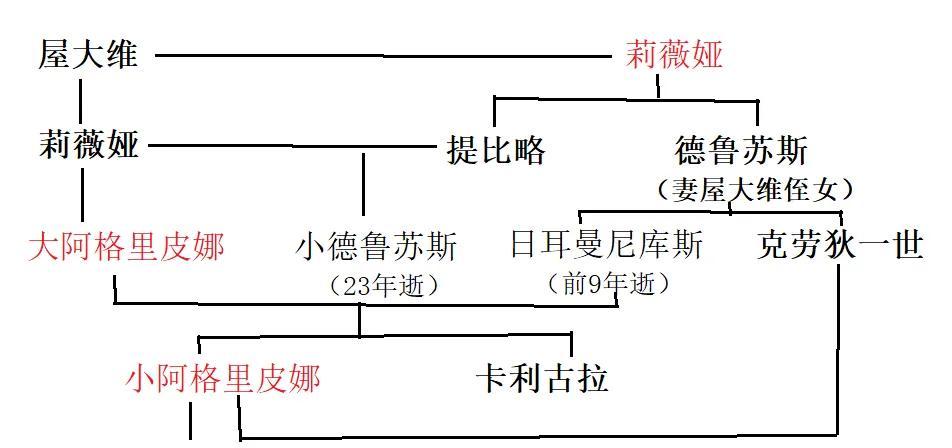1. Six prominent families in ancient Rome: the Manlius clan, the Fabian clan, the Emilius clan, the Claudius clan and the Valerius clan, and the Scipio family. Most of the early consuls of Rome came from these six families.
2. Octavian family: Octavian had only one daughter, livia, who was said to have married Theother's treasurer Laudius Nero, and Livia and her ex-husband had two sons, Tiberius and Drussus. Octavian's daughter Julia first married Marquelus, the son of Octavian's sister, and in 23 BC Marquelus died of food poisoning, and Julia remarried Agrippa: Gaius (died 4 BC), Lucius (died 2 BC), Vipsaniya, Grand Agrippina, and Postumus. Agrippa died in 12 BC, and Tiberius married Agrippa's widow Julia, Drussus the Younger (died 23). Tiberius' younger brother Drusus married Augustus's niece Antonia, who had sons Germanicus and Claudius I. Germanicus (died 9 BC) wife Agrippina the Eldest, gave birth to the younger Agrippina, Nero, Drusus, caligula, and in 30 years Tiberius enlarged the Agrippina family and adopted Caligula. In 49 years Claudius I's wife and niece Agrippina the Younger, Agrippina The Younger and her ex-husband Nero. All are married by close relatives.

3. Habsburgs: In 1273, the king of the Duchy of Swabia became the Eastern Roman Emperor Rudolf I, who was a member of the Habsburg family of Hohenstaufen, who was weak and capable, and was the best candidate for the emperor. In 1278 Rudolf united with Hungary to defeat Otto II, king of Bohemia, in occupying Austria. Because of its rapid expansion, after the death of Rudolf I in 1291, the German princes elected Adolf of Nassau as emperor, ending the habsburg rule.
In 1438, Duke Albrecht V of Austria succeeded his father-in-law to the thrones of Hungary and Bohemia, and became King of Germany again. Albrecht V died in 1439, and his cousin Frederick III became emperor. In 1477 Crown Prince Maximilian married Mary, the only daughter of charles, grand duke of Burgundy, and in 1482 Mary fell to her death on horseback, and their youngest son Philip I succeeded to Burgundy, Maximilian regent. In 1493 Maximilian became King of Germany, and Philip I administered Burgundy independently. In October 1496 Philip married Isabella I, Queen of Castile, and Juana, daughter of King Ferdinand II of Aragon (Crown Princess of Spain). In September 1506 Philip died of typhoid fever, and his son Carlos became King Charles V of Spain. Maximilian died of illness in 1519, and his eldest grandson Charles V was elected Holy Roman Emperor. Europe saw the emergence of a large empire that included Shinra, Spain, and the Netherlands.
4. The Medici family: In 1378 Salvestero Medici, the supreme magistrate of the Republic of Florence, was elected President of the Florentine Municipal Council, and was expelled from Florence after the fall of the democratically elected government in 1381. Giovanni Dibic de' Medici was the richest man in Florence, and in 1432 the eldest son, Cosimo, took over the papal treasury and became the uncrowned lord of Florence. In 1478, Pope Sixtus attacked and killed the Medici family Lorenzo and Giuliano, Giuliano was stabbed to death, Lorenzo fled to the church, foiled the pope's plot, and formed a council of seventy people instead of the Hundred.
In 1512 Piero's younger brother Cardinal Giovanni of the Medici family relied on Spanish troops to restore rule in Florence. The family was expelled in 1527 and returned to Florence three years later under the protection of the armies of the Holy Roman Empire. In 1567, the family's Corsimo was given the title of Grand Duke, and two years later the Grand Duchy of Tuscany was established, called Cosimo I. Florence became the capital of the principality, and the republic survived in name only. The Medici rule in Florence continued until 1737.
5, Lancastrian and York family: The War of the Roses is the Competition between Edward IV of the York family and Henry VI of the Lancastrian family for the throne. The point is that the Earl of Cambridge of the House of York married the descendants of Edward III's second son, and because the brother of the Earl of Cambridge had no heirs, the son of the Earl of Cambridge inherited the title of Duke of York, so they had more legal rights to inherit than the descendants of the old third family. It was fought for half a century of civil war.
6. Bourbon family: Robert, Count of Clermont, son of King Louis IX of France, married Beatrice , daughter of Hugo IV, Duke of Burgundy (heiress of the Bourbon Domain), and the eldest son, Louis, inherited the Bourbon Domain, and was made Duke of Bourbon by King Charles IV in 1327. In 1523, he was knighted by King François I of France, and his assets were temporarily returned to the French royal family. In 1527 the Duchy of Bourbon was granted to his niece and son-in-law, Charles, Duke of Vendôme, a branch of the Bourbon family. In 1548 Charles's eldest son (the second son was Prince condé), Ann Bourbon, married Crown Prince Navarre and had a son, Henry Bourbon (Henry IV), who succeeded to the kingdom of Navarre in 1572.